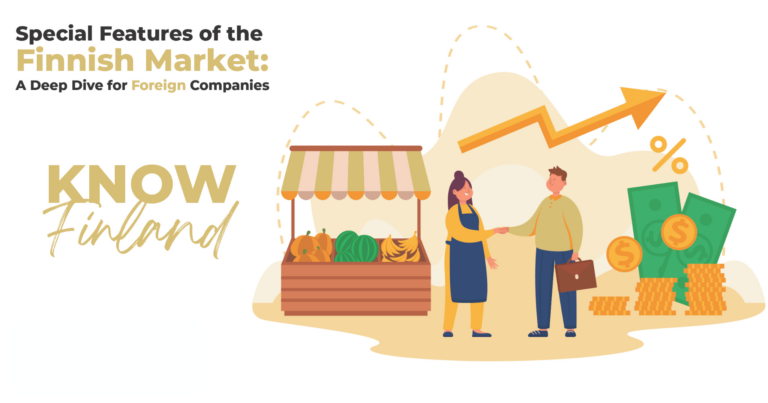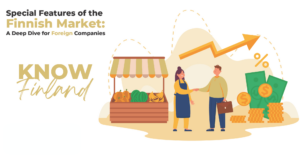Finland, a Nordic country that lies at the crossroads of Western and Eastern Europe, presents an attractive opportunity for foreign businesses looking for a winning market entry strategy to enter the European market. With its high-quality infrastructure, highly skilled workforce, and impressive track record for innovation and competitiveness, Finland stands as an ideal entry point to the broader European Union (EU) market. Finland’s membership in the EU provides foreign companies access to one of the largest integrated markets in the world. The country’s strengths in sectors such as technology, healthcare, and clean energy are particularly appealing to foreign companies, thanks to its focus on sustainability, innovation, and government support for foreign investment.
However, foreign businesses seeking to expand into the Finnish market often face several challenges, primarily due to information gaps. Companies unfamiliar with local consumer behavior, business culture, and regulatory frameworks may struggle to effectively penetrate the market. Additionally, foreign companies may face competition from domestic brands that are deeply ingrained in Finnish culture.
The purpose of this blog post is to provide foreign businesses with a comprehensive understanding of the unique characteristics, trends, challenges, and opportunities of the Finnish market, including key statistics and actionable insights.
Unique Characteristics of the Finnish Market:
Consumer Behavior:
Finnish consumers are known for their sophisticated purchasing decisions, which are driven by a combination of quality, functionality, and sustainability. According to Advertising Finland’s report (2024), 69% of Finnish consumers are carefully considering their purchasing habits, with 63% becoming more cautious when making purchasing decisions. This behavior reflects a preference for products that are not only high-quality and functional but also offer long-term value. This cautious approach suggests that foreign companies need to position their products in a way that highlights their durability and reliability, which are highly valued in Finland.
Sustainability is another major factor influencing Finnish consumer behavior. Finnish consumers are increasingly buying products that adhere to their ethical values, especially those related to environmental impact and sustainability. This trend is particularly strong in industries such as food, retail, and technology (Lloyds Bank Trade, 2024). For foreign companies entering Finland, it’s critical to integrate sustainable practices into their product offerings, as consumers expect these practices to be embedded within the brands they support.
One challenge foreign companies face in Finland is the strong preference for local brands. Finnish consumers have a deep-rooted loyalty to domestic products, as these are often perceived as more trustworthy and authentic. According to research, local products are given priority over foreign alternatives, especially when it comes to reliability and quality (Lloyds Bank Trade, 2024). Therefore, foreign companies must emphasize their product’s uniqueness and quality to establish credibility in this competitive market.
In terms of e-commerce, Finland has seen significant growth in online shopping. Approximately 7-10% of total retail sales are made online, and e-commerce makes up about 3% of the country’s grocery sales (Lloyds Bank Trade, 2024). Although online shopping is growing rapidly, mobile payments are still lagging behind other Nordic countries (Nets Group A/S, 2024). Therefore, businesses looking to expand into Finland should understand the pace of digital adoption and adapt their e-commerce strategies accordingly.
Business Culture:
The Finnish business culture places a high value on punctuality, directness, and consensus-building. Meetings in Finland are typically brief and to the point, with a clear agenda set to avoid wasting time. Finnish professionals are known for their direct communication style, which can be perceived as blunt in cultures where indirect communication is more common. However, this directness is rooted in a desire for transparency and efficiency (Scandicorp, n.d.).
Trust plays a crucial role in the Finnish business landscape. While personal relationships are important, they are not necessary to conduct business. The focus is instead on mutual respect, transparency, and shared values. Once trust is established, Finnish business relationships tend to be very stable and long-lasting (Commisceo Global, n.d.).
Finnish companies also tend to have flat organizational structures, which promote open communication and collaboration across different levels of the company. These flatter structures encourage employees at all levels to contribute their ideas and feedback, fostering an environment of inclusivity and transparency. Additionally, Finnish businesses often maintain strong connections with trade unions, which are influential in the workplace and ensure workers’ rights are well-protected.
Regulatory Environment:
Finland’s legal and regulatory environment is known for being stable, transparent, and business-friendly. The country’s legal system operates with low levels of corruption, and businesses, both domestic and foreign, are treated equally under the law. Foreign businesses entering the Finnish market are afforded the same rights and opportunities as Finnish-owned companies. Finland also offers various government and EU incentives to foreign businesses, including grants, loans, and guarantees aimed at promoting innovation and facilitating market entry (State.gov, 2023).
The Finnish Competition and Consumer Authority (FCCA) oversees consumer protection and ensures that businesses comply with fair practices, particularly regarding product safety, pricing, and advertising. Foreign companies must comply with these regulations to operate successfully within Finland (FCCA, 2024).
Finnish Market Trends and Opportunities:
Digitalization:
Finland has long been a leader in digital innovation. The country’s high level of digitalization has transformed several sectors, including retail, education, and healthcare. Finland ranks among the top countries globally for internet connectivity, with almost 80% of the population having access to high-speed broadband in the third quarter of 2023 (Traficom, 2024). This digital infrastructure has spurred the growth of e-commerce, and businesses that adapt their operations to the digital landscape are more likely to succeed.
Sustainability:
Sustainability is a major driving force in Finland’s business landscape. Consumers and businesses alike are focused on reducing environmental impacts, and Finland has implemented numerous initiatives to promote sustainability. For instance, Finland is one of the global leaders in renewable energy consumption, with wind power being the country’s second-largest electricity production method (Renewables Finland, 2025). Companies entering Finland should consider offering eco-friendly products and services to align with the country’s sustainability goals and meet consumer demand.
Furthermore, Finland’s government offers various incentives for businesses that adopt sustainable practices. This focus on sustainability creates opportunities for foreign companies, particularly those in industries such as renewable energy, eco-friendly technology, and waste management.
Aging Population:
Finland is experiencing an aging population, which poses both challenges and opportunities. The demand for healthcare services, senior care, and products aimed at older adults is rising steadily. This demographic shift presents an opportunity for businesses in the healthcare, senior care, and pharmaceutical sectors to cater to the needs of an aging population.
Finnish Market Challenges and Considerations:
Language Barrier:
While many Finns are fluent in English, language skills in Finnish and Swedish are still important for effective communication, especially in business dealings. Although translation services and professional interpreters are readily available, foreign companies may find it challenging to build deep relationships without a basic understanding of the local languages.
Competition:
Finland is a highly competitive market, with both strong domestic players and international companies vying for market share. Companies in sectors such as technology, retail, and consumer goods will find themselves competing against established Finnish companies that have a solid reputation and consumer trust. Foreign companies must offer distinct value propositions or innovative products to gain a competitive edge.
Seasonal Variations:
Finland’s business environment is also impacted by seasonal variations, particularly in the tourism and retail sectors. For example, the tourism industry sees significant peaks during the winter months due to the country’s appeal as a winter sports destination. Retailers also experience fluctuations in sales during different seasons, with holidays such as Christmas and Easter driving increased demand.
Conclusions:
Finland offers substantial opportunities for foreign companies looking to expand into the European market. Understanding the unique characteristics of Finnish consumer behavior, business culture, and the regulatory environment is crucial for success. Companies must also adapt to market trends such as digitalization, sustainability, and the aging population. Despite challenges like language barriers, competition, and seasonal variations, Finland offers a promising opportunity for businesses planning their market entry strategy.
Foreign companies interested in expanding into Finland can access additional resources through government websites, business councils, and consulting firms that specialize in market entry. Leveraging local expertise and conducting thorough market research will ensure a smooth and successful entry into the Finnish market. Connect with us at Frog and Scorpio Communications to discuss your market entry strategy.
References:
State.gov. (2023). 2023 Investment Climate Statements – Finland. Retrieved from https://www.state.gov/reports/2023-investment-climate-statements/finland
Advertising Finland. (2024). How is the Finnish consumer doing in 2024? Retrieved from https://www.advertisingfinland.com/how-is-the-finnish-consumer-doing-in-2024
Lloyds Bank Trade. (2024). Finland Market Potential & Marketing Insights. Retrieved from https://www.lloydsbanktrade.com/en/market-potential/finland/marketing
Nets Group A/S. (2024). Nordic Payment Report 2024. Retrieved from https://insights.nets.eu/publication/nordic-payment-report-2024
Scandicorp. (n.d.). Guide to Finnish Business Culture and Etiquette. Retrieved from https://scandicorp.com/guide-to-finnish-business-culture-and-etiquette
Commisceo Global. (n.d.). Finnish Business Culture. Retrieved from https://www.commisceo-global.com/resources/country-guides/finland-guide
Finnish Competition and Consumer Authority. (2024). Retrieved from https://www.kkv.fi/en/
Traficom. (2024). Almost 80% of Finnish households have access to a fast fixed internet connection. Retrieved from https://www.traficom.fi/en/news/almost-80-finnish-households-have-access-fast-fixed-internet-connection
Renewables Finland. (2025). Wind power became Finland’s second-largest electricity production method. Retrieved from https://suomenuusiutuvat.fi/en/wind-power-became-finlands-second-largest-electricity-production-method/






